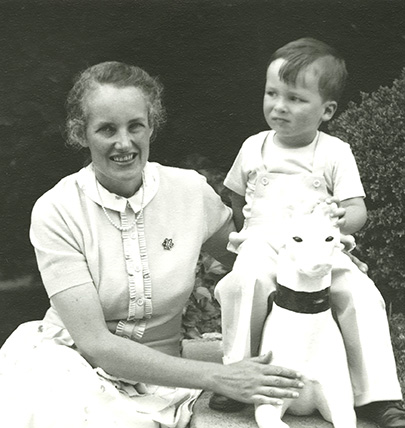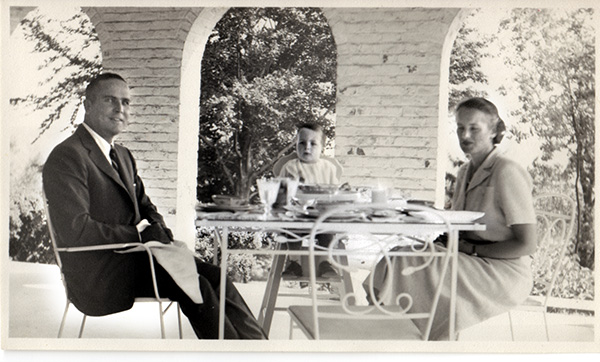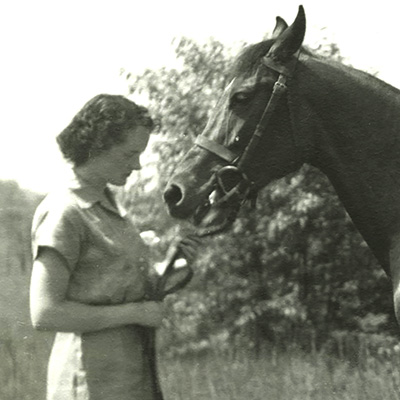Adelaide Frick Blanchard
Many individuals, no longer living, have made their mark on the landscape of Greenwood Gardens. Just as we acknowledge that Greenwood persists today only because of a team effort of its board, staff, volunteers, and friends, so the Gardens were founded by team efforts both in the Day and Blanchard eras.
I don’t remember my mother, Adelaide, at all well. She passed away in 1956, when I was five years old. My recollections center on brief golden moments, when she chased me through a sprinkler system; guided me in lawn mowing with a miniature mower made of wood and introduced me to the newly born lambs, frisking under heat lamps in the barn. But her warmth, support, and love certainly permeated my earliest years and persist today in the realm of my subconscious.
I certainly remember aspects of Adelaide’s life as relayed to me by my father, Peter P. Blanchard Jr. A key theme was her independence and rebelliousness from an early age. Growing up in Roslyn, Long Island she was a spirited girl who tended to “buck” expectations. When “coming-out” parties were the norm for young ladies of a certain background, she steadfastly declined the opportunity. As depicted in the photographs and home movies (!) from the era of World War I and the Roaring Twenties, she enjoyed a happy and active existence as the oldest child of Childs and Frances S. Dixon Frick with her three siblings: Frances, Marsie and Clay. At her Roslyn home, Clayton, (now a county park) she took part in innumerable games and outings with a general outdoor focus. Her mood appears to have been at times pensive, at times happy, but she was never far from a smile. My own interpretation of her childhood is that she was rough and tumble, something of a tomboy.
Young Adelaide shared with her family an enormous fondness for animals of various sorts—a fondness which would find ample expression during her later years at Greenwood. The menagerie at the Frick household contained, (among other inhabitants), parrots, chickens, ducks, doves, swans, horses, donkeys,long-haired dachshunds (in quantity), and a monkey of an unrecorded species, which (my Dad maintained) would pick up visitors’ hats at the front door of Clayton and deposit them at a coat check.
In light of Adelaide’s future work in medicine and in light of a mischievous streak characteristic of the girl, a particular tale bears telling. While sick in bed at an early age, Adelaide anticipated her pediatrician’s visit. It would be the last house call the doctor would ever make at Clayton. He pulled back the covers to inspect the patient only to find a large Black snake curled up next to her, basking in her body heat. The doctor made a hasty retreat with Adelaide’s condition undiagnosed.
Along with her two sisters, Adelaide attended the Foxcroft School in Middleburg, Virginia. She graduated in 1933. As was apparently common at the time, each girl boarded her own horse.
In the years immediately before World War II, my mother fully broke with the expectations of a woman’s role in society; she was drawn to a career path almost completely dominated by men. She chose a medical career. Coursework abroad and at the University of Pittsburgh allowed her to prepare for and achieve admission to Yale Medical School. She graduated in 1943 with an MD degree. Following medical work in war-torn Germany, immediately following war’s end, she began a pediatric practice at New York Hospital. My parents were commuters from New York City who soon established a home in Llewellyn Park, West Orange, New Jersey. This, of course, was prior to their discovery of Pleasant Days, the future Greenwood.
One incident, only partly humorous, points to Adelaide’s determination and pluckiness as a parent. Presiding over Christmas lunch at Clayton, Addie’s father, Childs, had an unusual idea of holiday fun. A multitude of long-haired dachshunds frequented the house and passed freely between indoors and outdoors by means of trap doors in the dining room wall. Childs would grab the closest dachshund by the scruff of the neck and hoist it aloft onto his lap. Once this was accomplished, he gave the dog a slight slug of rye whiskey and then released it. To my mother’s horror, she looked down from the far end of the table and saw me in Child’s lap, receiving the same treatment as the dachshund. She charged over, grabbed me by the scruff of the neck, and pulled me up and away. She proclaimed, “If you treat the boy like this again, it will be the last time he will ever be in this house!!”
In full accord with the theme of Adelaide’s independence and feistiness, she and her husband nearly divorced during their first year of residence at Greenwood. While Peter planned to live in style in a colonial revival house (on the site of the Days’ former mansion), Adelaide had a very different vision: she set her sights on the Day Cowbarn, a Rookwood embellished, colonnaded barn, designed by William Renwick. The building promised a simpler and much more down-to-earth existence. Surrounded by woods southwest of the Carriage House, the Cowbarn was closer to Nature than the house site on the hill with its sweeping vistas. Her husband was drawn to the grander location where parties, receptions and gatherings of all kinds could be held. In this marriage, a true extrovert had found his opposite.
Adelaide’s life as wife, mother and physician was cut short by colon cancer. Following initial surgery with an optimistic prognosis, the cancer returned within a year and was widespread. In the difficult time of parting from her family and her home at Greenwood, she suffered great sorrow and pain. She was also greatly angered by the rapid and premature closure of a promising life. She died on March 30, 1956 at the age of 41.
Adelaide would be very pleased—most probably thrilled—at the progress and the promise of Greenwood. The allée of Norway Spruce that she and my father planted c. 1952, flanks and defines the entrance to
Greenwood. Her spirit certainly underlies the garden-building and garden restoration endeavor of the Blanchard era. Regarding Greenwood in the 21st century, I believe that she would pose a set of pressing questions: “This is all very fine but where is my bay, ‘Kindoon?’ Where is Peter’s grey, ‘Gladstone?’ Where are the horses??”
Photographs Courtesy of the Blanchard Family archives



Follow us on Instagram @greenwoodgardensnj
Use #howgreenwasourgarden for a chance to be featured
